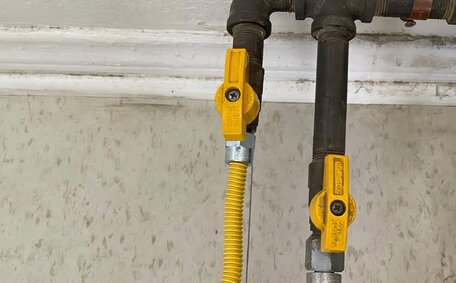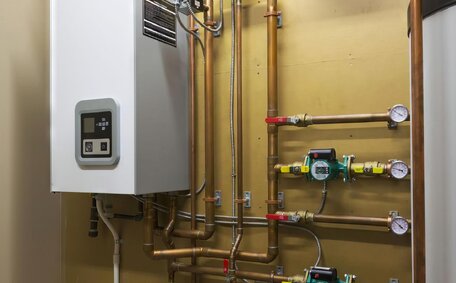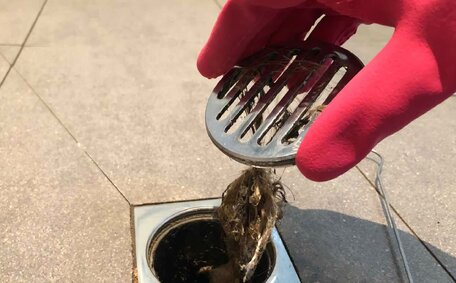How tankless water heaters work and what makes them different
Tankless water heaters revolutionise modern conveniences by providing instant access to hot water, eliminating the need for conventional storage tank heaters. Their continuous flow model provides endless hot water on demand, moving away from traditional storage tanks and offering substantial energy savings.
Cold inlet water is swiftly delivered to the heat exchanger, where it is swiftly heated as soon as you turn on the tap. As the fluid courses through the heat exchanger, it heats water using methods like solar hot water systems, heat pump innovations, or efficient electric elements.
Consider the trade-offs of tankless water heaters which, unlike traditional storage systems that constantly heat a reservoir of water, only heat the required amount for immediate use. It’s important to note, however, that maximum flow rates can be constrained under simultaneous high-demand, an important consideration for larger households.
The compact size of tankless heaters makes them a versatile option, fitting into smaller spaces within your home.
Sizing tankless heaters to meet the demands of large households
For optimal performance in a large family home, it is vital to correctly size the tankless water heater to meet your household’s hot water demands. Tankless heaters are gauged by their maximum flow rates, typically measured in litres per minute, to accommodate various needs. To gauge hot water needs, a demand water heater should ideally have a minimum first hour of flow rate at 14 litres per minute or 280 litres per hour for substantial usage.
With several showers, appliances, and fixtures in use at once, you might discover your peak demands aren’t met in a big household, unless you have a heater that would be large enough to provide enough capacity.
Consider the diverse factors such as the count of bathrooms and occupants, alongside lifestyle influences such as teenagers enjoying extended showers, all pivotal in choosing right water heating solutions. A suitably large water heater with higher flow rates can handle periods of high usage across multiple fixtures. Collaborating with installation experts is essential as they can demonstrate why we guide you on what you’ll need to ensure the right unit size to harmonise with your needs, factoring in your home’s unique hot water requirements and usage habits.
The costs of installing and operating a tankless system
The initial outlay for purchasing and installing tankless water heaters is often higher compared with traditional units utilising an electric storage water system. Gas tankless units can cost between $1,000 and $4,000, with the final price depending on size, fuel type, efficiency level, and complexity of installation.
More substantial and sophisticated gas water heaters, equipped to satisfy the demands of larger families, come with an increased cost. Installation factors into the price as well; electric models may need an electrical upgrade, while gas models require venting and appropriate gas lines.
Gas hot water options, however, offer long-term financial benefits from their energy efficiency and possible utility rebates. Eliminating standby heat losses, which are common with tank models, can cut annual energy bills by $100 or more, lowering overall energy costs. Additionally, tankless units often exceed the 10-15 year life expectancy of traditional tank heaters, typically lasting more than 20 years.
Maintenance is crucial though for operational efficiency and avoiding breakdowns. Annual inspections and flushing, costing around $200, should be performed to maintain efficiency. Overall, consider your financial plan and long-term benefits when selecting your water heater right for your water heating needs.
Comparing energy efficiency of tankless units vs traditional water heaters
Tankless water heaters typically outperform traditional storage systems in terms of energy efficiency. Tankless units only get water heated on-demand, eliminating standby heat losses associated with stored water remaining hot throughout the day and night.
Tankless models can achieve energy savings of 20%-50% compared to electric storage heaters due to their on-demand operation. High efficiency condensing tankless models that recycle exhaust heat can reach efficiency ratings over 90%, reducing energy bills substantially.
Tankless heaters with advanced modulating burners are also better at managing water temperature rise, utilising less energy when in operation. Their extended lifespan likewise lowers the environmental impact over time compared to systems needing to be replaced every 10-15 years.
Eco-conscious large families aiming to reduce energy consumption may find that a correctly sized heat pump hot water tankless heater is the most sustainable option, offering cost savings and a reduced carbon footprint for efficient hot water use.
Installing multiple units or larger systems for sufficient flow rates
A single tankless water heater may not cope with the high demand of a large family, potentially resulting in inconsistent water pressure. However, multiple units can adeptly meet the hot water demands, maintaining adequate flow when various outlets are used.
Installing several smaller tankless units ensures stable water pressure and sufficient capacity during peak demand. For instance, separate units for each bathroom can maintain consistent pressure and temperature.
Alternatively, a larger centralised system, when appropriately sized to the home’s peak water demands, can accommodate extensive use. Heaters with robust output, exceeding 25 litres per minute, may be essential to meet the expansive hot water needs of larger households.
Installing multiple units or a large, single system ensures a continuous hot water supply even during peak use in a bustling household.
Maintenance requirements and longevity of tankless systems
To efficiently and safely maintain your hot water system, these tankless heaters require several essential maintenance steps. It’s recommended to conduct annual inspections and flushing to eliminate scale-forming mineral deposits from internal components. Allowing deposits to accumulate can cause performance issues and reduce the unit’s lifespan.
Descaling helps optimise the system for maximum efficiency by keeping critical parts like the heat exchanger clear of obstruction. Such maintenance prevents issues such as flow restriction and overheating, particularly under the strain of heavy use in a large household. Some manufacturers recommend filters to improve incoming water quality as well.
Other important maintenance tasks include checking gas pressure/connections or the anode rod in electric heaters annually. Keeping your system well-maintained enhances reliability and can extend its operational lifespan to 20 years or longer - ensuring your investment remains problem-free for years to come.
Potential rebates and incentives for energy-efficient tankless heaters
Installing an energy-efficient tankless water heater that meets your needs could make you eligible for government rebates or other green incentives. Residents in the Jannali area have several options to investigate:
- The NSW government’s Energy Saving Scheme provides discounts on energy-efficient appliances purchased and installed by approved providers. Tankless water heaters may qualify for rebates up to $500.
- The Australian government’s Technology Investment Boost plan offers a tax deduction for businesses installing eligible assets like tankless hot water systems before June 2023.
- Contact your gas or electricity provider to inquire about potential rebates when investing in a new hot water system featuring high-efficiency tankless technology.
- Check with your local council regarding any environmental initiatives, discounts or consent fee waivers for eco-friendly plumbing system upgrades.
Discover more about cleanly energy programmes, both local and federal, to find possible rebates that make installing a tankless system more affordable. The long-term energy bill savings combined with any upfront incentives make it a worthwhile investment in sustainability for an environmentally-conscious household.
Making the decision: Are tankless systems practical for your large family?
When considering a new gas hot water system, such as a tankless heater for your large household, balancing the initial investment against potential long-term savings and energy efficiency is key.
While more expensive to purchase and install initially, the superior energy efficiency and lower running costs, as well as the cons tankless systems can present, can pay dividends over their extended lifetime compared to traditional water heaters.
Assess your family’s hot water needs at peak times and the feasibility of tankless heaters that provide immediate heating. Unusually high simultaneous demand might require additional units or a larger system to guarantee sufficient flow.
Keep in mind tankless systems do need annual maintenance like flushing to prevent mineral buildup and ensure optimal performance under heavy household usage.
For tailored advice and to make an informed decision about your large family’s hot water needs, reach out to Jannali Plumbing via phone, email, or by booking an appointment. We offer expert guidance on the practicality of a new tankless system for meeting your household’s hot water requirements.






